基于原型证据神经网络的远程冲突管理
IF 3
3区 计算机科学
Q2 COMPUTER SCIENCE, ARTIFICIAL INTELLIGENCE
引用次数: 0
摘要
尽管基于信念函数的综合推理在推广概率表示方面取得了进展,但基于距离到原型的证据深度神经网络仍在兴起,需要进一步巩固。现有的分割或分类任务研究通常执行预先初始化,而没有解决或减轻融合过程中可能出现的潜在冲突。这项工作研究了自动驾驶中用于分割的证据神经网络中的高冲突场景,重点关注到原型的距离组件,其中原型来自特征地图,作为证据来源,可能会产生矛盾的信息。通过在证据推理中调整参数来缓解冲突,增强融合前的一致性。这可以实现更可靠的数据集成,并有效地应用融合规则和决策过程。采用两种基于距离的决策策略和自适应指标,在深度证据激光雷达-相机交叉融合架构的两种原型配置上验证了所提出的校正方法。通过KITTI数据集的道路检测任务的定性和定量结果,证明了对网络预测的影响。本文章由计算机程序翻译,如有差异,请以英文原文为准。
Conflict management in a distance to prototype-based evidential neural network
Despite advances in integrating reasoning based on belief functions to generalise probabilistic representations, distance-to-prototype-based evidential deep neural networks are still emerging and require further consolidation. Existing studies in segmentation or classification tasks typically perform prior initialisation and do not address or mitigate the potential conflicts that may arise during fusion. This work investigates high-conflict scenarios within an evidential neural network for segmentation in autonomous driving, focusing on the distance-to-prototypes component, where prototypes, derived from feature maps, serve as sources of evidence and may yield contradictory information. Conflict is mitigated through parameter adjustments within the evidential reasoning, enhancing consistency before fusion. This enables more reliable data integration and a valid application of fusion rules and decision-making processes. The proposed rectification is validated on two prototype configurations of a deep evidential lidar-camera cross-fusion architecture, using two distance-based decision strategies and adapted metrics. The impact on the network's predictions is demonstrated through qualitative and quantitative results on road detection tasks with the KITTI dataset.
求助全文
通过发布文献求助,成功后即可免费获取论文全文。
去求助
来源期刊

International Journal of Approximate Reasoning
工程技术-计算机:人工智能
CiteScore
6.90
自引率
12.80%
发文量
170
审稿时长
67 days
期刊介绍:
The International Journal of Approximate Reasoning is intended to serve as a forum for the treatment of imprecision and uncertainty in Artificial and Computational Intelligence, covering both the foundations of uncertainty theories, and the design of intelligent systems for scientific and engineering applications. It publishes high-quality research papers describing theoretical developments or innovative applications, as well as review articles on topics of general interest.
Relevant topics include, but are not limited to, probabilistic reasoning and Bayesian networks, imprecise probabilities, random sets, belief functions (Dempster-Shafer theory), possibility theory, fuzzy sets, rough sets, decision theory, non-additive measures and integrals, qualitative reasoning about uncertainty, comparative probability orderings, game-theoretic probability, default reasoning, nonstandard logics, argumentation systems, inconsistency tolerant reasoning, elicitation techniques, philosophical foundations and psychological models of uncertain reasoning.
Domains of application for uncertain reasoning systems include risk analysis and assessment, information retrieval and database design, information fusion, machine learning, data and web mining, computer vision, image and signal processing, intelligent data analysis, statistics, multi-agent systems, etc.
 求助内容:
求助内容: 应助结果提醒方式:
应助结果提醒方式:


